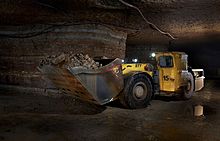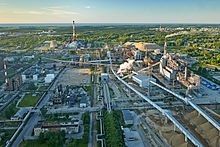
Kohtla-Järve is a city and municipality in northeastern Estonia, founded in 1924 and incorporated as a town in 1946. The city is highly industrial, and is both a processor of oil shales and is a large producer of various petrochemical products. During the 1944–1991 Soviet occupation, large numbers of immigrant workers from Russia and other parts of the former USSR were brought in to populate the rapidly growing city. The population in the Kohtla-Järve area which had been, as of 1934 census, over 90% ethnic Estonian, became overwhelmingly non-Estonian in the second half of the 20th century. According to more recent data 21% of the city's population are ethnic Estonians; most of the rest are Russians. Kohtla-Järve is the fifth-largest city in Estonia in terms of population.

Eesti Energia AS is a public limited energy company in Estonia with its headquarters in Tallinn. It is the world's biggest oil shale to energy company. The company was founded in 1939. As of 2014, it operates in Estonia, Latvia, Lithuania, Finland, Jordan and Utah, United States. In Estonia, the company operates under the name Eesti Energia, while using the brand name Enefit for international operations. The main raw material for energy production – oil shale – is extracted from mines located in Eastern-Estonia and owned by the company. The group of Eesti Energia has three main operation areas: electricity generation, shale oil production, and sale and distribution of electricity. Its shares are owned by the Government of Estonia.
Enefit Kaevandused was a mining company located in Jõhvi, Estonia. It was a subsidiary of Eesti Energia, an Estonian state-owned energy company. The core activity of Enefit Kaevandused was oil-shale mining. The produced oil shale was mainly used for shale oil production and to fuel oil shale-fired power stations in the north–east of Estonia. As of 2009, the company has 3,150 employees. The last chief executive officer was Andres Vainola. The company produced more than 17 million tons of oil shale in 2013.

The Narva Power Plants are a power generation complex in and near Narva in Estonia, near the border with Leningrad Oblast, Russia. The complex consists of the world's two largest oil shale-fired thermal power plants, Eesti Power Plant and Balti Power Plant. In 2007, Narva Power Plants generated about 95% of total power production in Estonia. The complex is owned and operated by AS Narva Elektrijaamad, a subsidiary of Eesti Energia.

The history of the oil shale industry started in ancient times. The modern industrial use of oil shale for oil extraction dates to the mid-19th century and started growing just before World War I because of the mass production of automobiles and trucks and the supposed shortage of gasoline for transportation needs. Between the World Wars oil shale projects were begun in several countries.
Oil shale gas is a synthetic non-condensable gas mixture (syngas) produced by oil shale thermal processing (pyrolysis). Although often referred to as shale gas, it differs from the natural gas produced from shale, which is also known as shale gas.
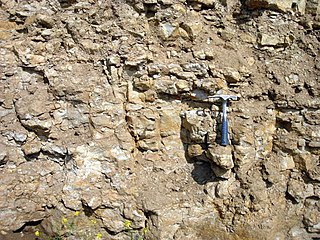
There are two kinds of oil shale in Estonia, both of which are sedimentary rocks laid down during the Ordovician geologic period. Graptolitic argillite is the larger oil shale resource, but, because its organic matter content is relatively low, it is not used industrially. The other is kukersite, which has been mined for more than a hundred years. Kukersite deposits in Estonia account for 1% of global oil shale deposits.

Narva Oil Plant is a commercial scale shale oil retorting facility located in Auvere near Narva, Estonia. The plant produces shale oil from oil shale by using Galoter/Eneffit technology. The facility belongs to Enefit Energiatootmine, a subsidiary of Eesti Energia.
The Kiviter process is an above ground retorting technology for shale oil extraction.
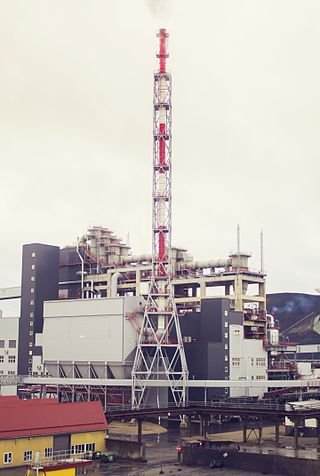
The Galoter process is a shale oil extraction technology for a production of shale oil, a type of synthetic crude oil. In this process, the oil shale is decomposed into shale oil, oil shale gas, and spent residue. A decomposition is caused by mixing raw oil shale with a hot oil shale ash, generated by combustion of carbonaceous residue (semi-coke) in the spent residue. The process was developed in 1950s and it is used commercially for the shale oil production in Estonia. There are projects for further development of this technology and for expansion of its usage, e.g. in Jordan and USA.
The Alberta Taciuk process is an above-ground dry thermal retorting technology for extracting oil from oil sands, oil shale and other organics-bearing materials, including oil contaminated soils, sludges and wastes. The technology is named after its inventor William Taciuk and the Alberta Oil Sands Technology and Research Authority.
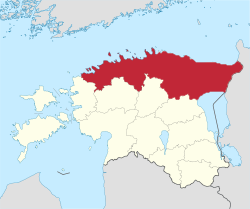
Northern Estonia is a geographical region of Estonia, consisting of the three northernmost counties - Harju County, Ida-Viru County and Lääne-Viru County. The largest towns of Northern Estonia are Tallinn, Narva, Kohtla-Järve and Rakvere. Northern Estonia is the most populous area in Estonia, with 60.3% of the population living there.

VKG Elektrivõrgud is an electricity distribution company in Estonia. It is a subsidiary of Viru Keemia Grupp. VKG Elektrivõrgud is the second-largest power distribution company in Estonia, after Eesti Energia Jaotusvõrk.

Ahtme Power Plant was an oil shale-fired power plant in Ahtme, Kohtla-Järve, Estonia. It was owned by VKG Soojus, a subsidiary of Viru Keemia Grupp. Until the end 2012, it supplied with heat Ahtme district of Kohtla-Järve and Jõhvi.
The Kohtla-Järve Power Plant is an oil shale-fired power plant in Kohtla-Järve, Estonia, about 15 km to north-west of the Ahtme Power Plant. It is owned by VKG Soojus, a subsidiary of Viru Keemia Grupp. It consists of Põhja Power Plant and Lõuna Power Plant.

Esimene Eesti Põlevkivitööstus was an oil shale company located in Kohtla-Järve, Estonia. It was a predecessor of Viru Keemia Grupp, a shale oil extraction company.
Eestimaa Õlikonsortsium was an oil shale company located in Sillamäe, Estonia. The company was established in 1926. It was a Swedish–Norwegian consortium controlled by Marcus Wallenberg. Main shareholders were Investor AB, AB Emissionsinstitutet, and Norsk Hydro.

New Consolidated Gold Fields Ltd Estonian Branch was an oil shale company located in Kohtla-Nõmme, Estonia. It was a subsidiary of Consolidated Gold Fields.
Nitrofert AS is a manufacturer of fertilizers based in Kohtla-Järve, Estonia. It is a subsidiary of Ostchem Holding, owned by Ukrainian oligarch Dmytro Firtash.

Narva-Jõesuu is an urban municipality of Estonia, in Ida-Viru County. It comprises the town of Narva-Jõesuu, settlements of the former parish of Vaivara, and two former distant exclaves of the urban municipality of Kohtla-Järve. The municipality surrounds two exclave neighbourhoods of the city of Narva, Olgina and Kudruküla, both of which share their names with an adjacent village in Narva-Jõesuu municipality.


